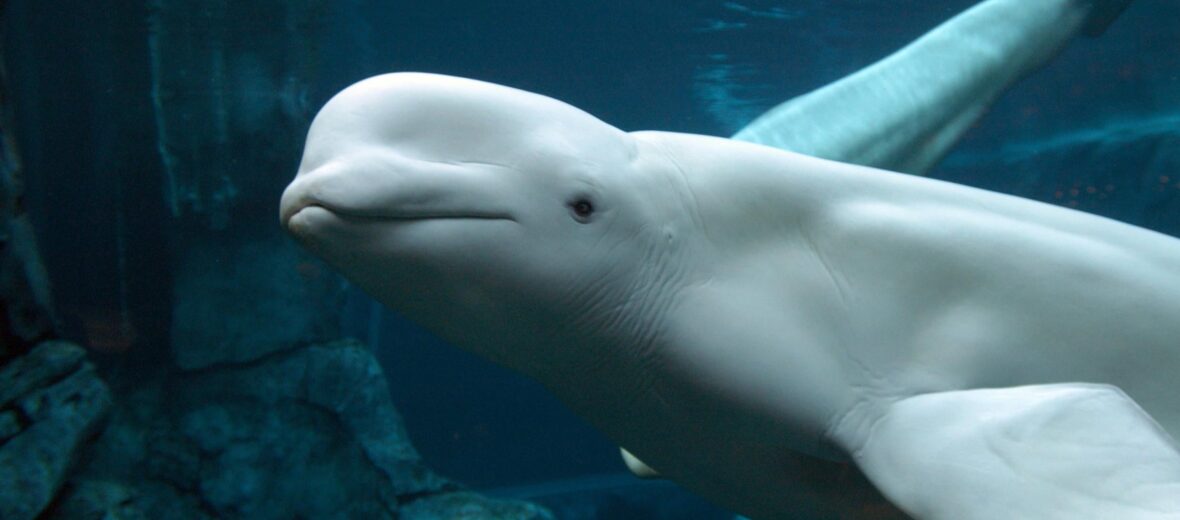
The beluga whale, aka white whale or sea canary, calls the frigid Arctic waters its home. These beautiful white whales rely on their coloration to blend in with their icy surroundings. Belugas are considered to be the most vocal of all cetaceans. Despite human interference, at the hands of overfishing, shipping lanes (boat strike), the oil industry degrading their habitat, and climate change these critters are listed as Least Concern by the IUCN; with an estimated 136,000 in the wild.
First the Stats…
Scientific name: Delphinapterus leucas
Weight: Up to 3,000 lbs.
Length: Up to 14 feet
Lifespan: Up to 50 years
Now on to the Facts!
1.) That large bump on their head is called a melon. Belugas can change the shape of this melon by blowing air into and around its sinuses.
2.) The name beluga comes from the Russian word “bielo” which means white.
3.) They prefer water that is about 32°F.
4.) The beluga whale is very closely related to the narwhal. The 2 are the only members of the Monodontidae family.
5.) Belugas can make whistles, chirps, cackles, squawks, and 7 other sounds. Hence the nickname canary of the sea.
But wait, there’s more on the beluga whale!
6.) Beluga whales have no dorsal fin, like other known Arctic whales. Instead of a dorsal fin, they have a dorsal ridge that is used to break through thick ice, to create breathing holes.
7.) Unlike other whales, these critters can actually subtly turn their heads to allow for a greater field of vision.
Did you know…?
Their dives can reach depths of up to 2,400 feet and can last upwards of 25 minutes!
8.) Unique in beluga whales, they can actually swim backwards.
9.) Not being picky at all, these carnivores (eat meat) prey on salmon, octopus, squid, snails, eulachon, shrimp, crabs, clams, mussels, sandworms, flounder, and cod.
10.) Polar bears and orcas have been known to hunt belugas.
But wait, there’s still more on the beluga whale!
11.) Echolocation is achieved via the whale’s melon. It is used to emit sound waves that detect a number of things in the water, from distance, speed, size, shape, to even the internal composition of objects (like how thick ice may be).
12.) Females birth a single calf after a 14 – 15 month gestation (pregnancy).
13.) The calf is 4 – 6 feet long! Ouch.
Did you know…?
A captive beluga whale, in 2009, rescued a distressed girl of a free diving competition by pushing her to the surface.
14.) Belugas are born grey and turn white as they age.
15.) Even though they are a toothed whale, they tend to swallow their prey whole.
But wait, there’s a little more on the beluga whale!
16.) Beluga whales are very social and friendly. They can be found in pods of around 10 whales. During migration though, there can be thousands of belugas.
17.) The beluga whale is a curious and playful species that is often seen playing with makeshift toys, like pieces of wood, plants, bubbles, and dead fish.
18.) Captive belugas have been documented mimicking human speech. A beluga whale named Noc, who lived at the National Marine Mammal Foundation in San Diego, was one of the first heard to display this behavior. Noc actually convinced a diver to climb out of the whale’s tank when he heard what he thought was someone telling him to do so. It was actually Noc copying the word “out”.
Now a Short Beluga Whale Video!
Also, check out the Critter Science YouTube channel. Videos added frequently!
Want to suggest a critter for me to write about? Let me know here.



